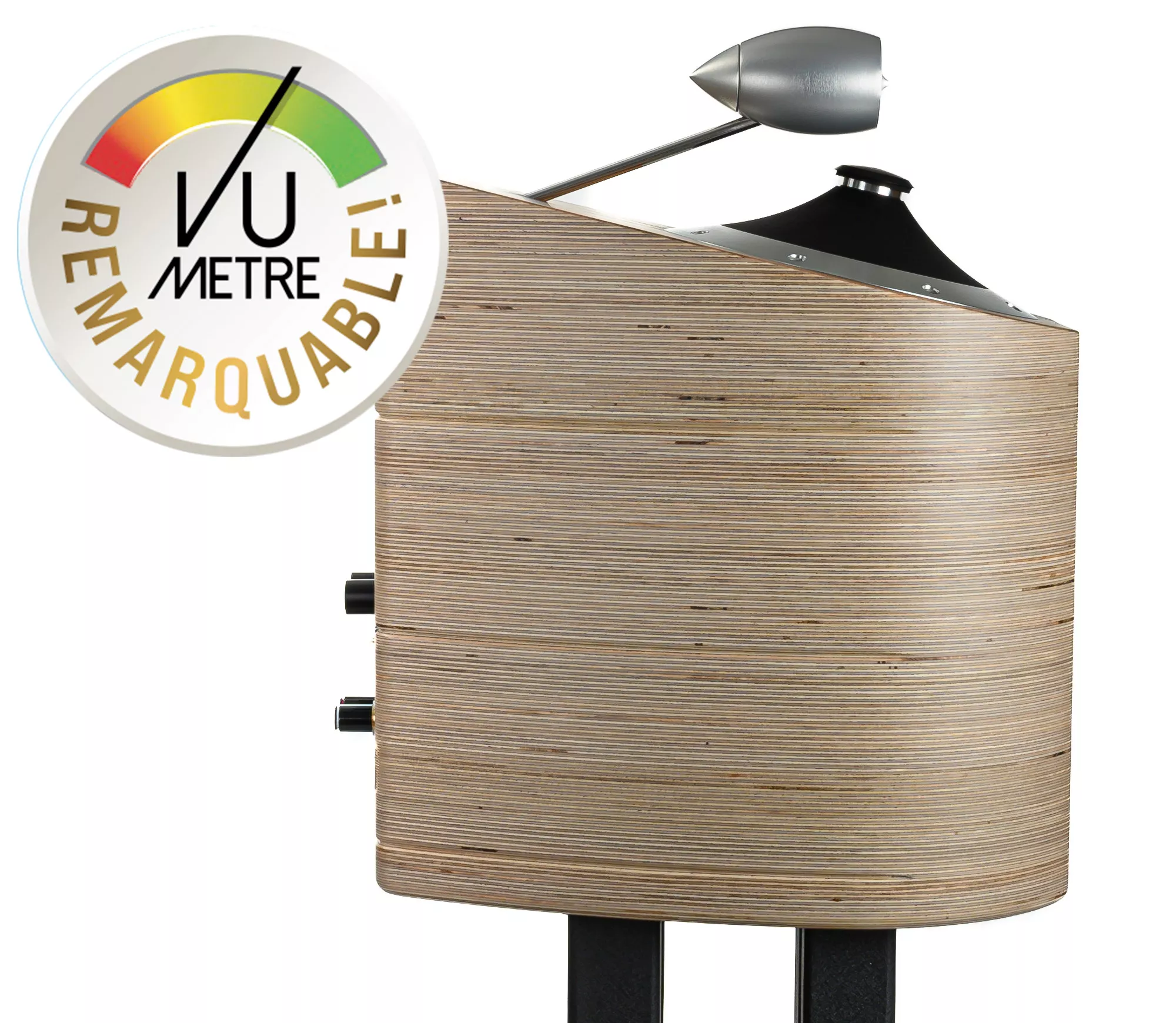"They brought refined tonal variety, natural warmth, and immersive soundstaging—all without exaggeration or harshness. Tube amps unlock their full potential, though they don’t require excessive power."

Ilumnia Vocalis MKII - AUDIOPHILE MAGAZINE
Review (English version)
Ilumnia Vocalis
Following a listening session at Voir & Émouvoir, I finally received a pair of Ilumnia monitors at home to dig deeper beyond those initial impressions in the shootout against the Kii Seven (see issue 17 of Audiophile Magazine).
These Belgian-made speakers are distributed in our region by Stefaan Strypsteen from Musikii. The creation of the company—or rather the Ilumnia project—goes back to 2010. A team of passionate music lovers (Jef Nuyts, Tom Nuyts, Lukas van der Sterren, Frank Essink, and Felix de Schwartz) sought to develop an innovative concept using a full-range cone that floats on its own electromagnetic suspension, thus eliminating the mechanical constraints inherent to traditional speaker suspensions.
This project, which began in 2010, became a commercial reality in 2017.
The Ilumnia concept aims to eliminate the main sources of non-linearity and distortion—namely, the spider and rubber suspension of conventional speakers. Their unique architecture allows 100% of the amplifier's energy to be directed exclusively into the cone.
While some earlier solutions attempted to reduce these parasitic effects—like Gilles Milot's ferrofluid joint suspension—the Ilumnia LEMS (Linear Excursion Motor System) design is a different approach altogether, maintaining the benefits of a paper-cone speaker while freeing it from mechanical limitations.
The Ilumnia speakers use a 23 cm coated paper cone that moves without a suspension, powered by a coil at its center and directed vertically to radiate sound concentrically around it.
The LEMS driver contains no fewer than 69 parts, allowing the cone to float within its magnetic field. The LEMS motor serves two functions: maintaining the cone’s central position via a controlled magnetic field and transmitting the musical signal like a traditional transducer. These functions are completely galvanically isolated from each other.
A separate decompression chamber, combined with an aluminum ring glued to the cone, neutralizes the typical under- and over-pressure created by cone movement—aiming to eliminate resonances, distortion, energy absorption, and non-linear behaviors often found in dynamic speakers.
To minimize Doppler effect, the speaker is tilted slightly upward. The Magister is angled at 9°, and the Vocalis at 13°.
The high frequencies are handled by an unbaffled 2.6 cm silk-dome tweeter from Scan-Speak, suspended in an ovoid enclosure above the mid/bass driver, mounted on an aluminum rod. Its height allows for an extremely minimalist crossover, with no phase correction needed.
Another unique trait: due to the electromagnetic suspension, the speakers require AC power—so you’ll need an outlet near each speaker. This might complicate placement, especially far from rear walls, as both signal and power cables become more visually intrusive.
The high-quality cabinet is made from CNC-machined birch plywood, assembled by hand. Its curved walls (concave/convex) help avoid parallel surfaces and standing waves. The Vocalis features a rear-firing port, machined directly into the body, which is depth-adjustable to fine-tune bass response. This two-part port (inner and outer tube) allows frequency response adjustments of up to ±5 Hz.
Additional adjustments on the rear panel allow you to tailor the speaker’s response above 50 Hz:
- A 3-position switch adjusts the mid-bass range (50–500 Hz)
- Two potentiometers adjust the midrange (400 Hz–10 kHz) and treble (3–20 kHz)
Each setting also has a neutral position that retains the factory tuning.
Specs:
- Frequency response: 40 Hz – 25 kHz (±3 dB)
- Sensitivity: 88 dB (2.83 V / 1 W / 1 m)
- Nominal impedance: 8 ohms (min. 6 ohms)
- Dimensions: 48 cm (H) x 28 cm (W) x 40 cm (D)
- Weight: 17 kg per speaker
Note: Despite what some images may suggest, the Vocalis MK2 NE are not sold with stands. The stands used in this review were custom-built by the French distributor, and given the speakers’ unique shape, it's unfortunate the manufacturer doesn't offer matching stands.
Listening Impressions:
Listening in a familiar environment always offers a better perspective.
The Ilumnia Vocalis MK2 NE truly surprised me. I expected them to be less versatile, but they proved adept across a wide variety of recordings without showing any real weaknesses for specific genres. They're not tied to any one musical style—a sign of a well-designed speaker.
Their coherence is notable—like that of a two-way or even a full-range driver, especially as the crossover with the tweeter happens at 10 kHz. The lack of mechanical suspension enhances the sense of a near-perfect full-range speaker, with no breakup or tonal inconsistency. They reminded me of my old JLA Acoustique Perspective 2—but with their flaws erased and their charm intact.
Like many full-range designs, they require proper amplification to shine. While various amps performed reasonably, the best results came with Coincident Speaker Technology Turbo 845 SE monoblocks. The Vocalis clearly favor tube amplification, especially single-ended triode configurations (as long as there's enough power).
If I had a critique, it would be the tweeter’s directivity, which contrasts slightly with the LEMS’s dispersion. Still, the integration is excellent, and thanks to the minimalist crossover, the illusion of a seamless full-range driver is very convincing.
The stereo image is outstanding.
Listening to "Amériques" by Edgar Varèse, the soundstage is vast—wide, tall, and deep. Whether it’s due to the upward-facing LEMS driver or something else, the Vocalis filled my room completely, well beyond the physical limits of the speakers.
Orchestral passages are powerful and clear, with natural, colorful timbres, and none of the harshness sometimes found in full-range drivers. The dynamics are lively, especially with tube amps.
Switching to Fabio Biondi’s Europa Galante, the speakers easily rendered changes in acoustic environments, demonstrating high fidelity and neutrality. The tonal accuracy and resolution made me feel like I was listening to the master tape.
On "Vivaldi: I concerti dell’addio", the balance between soloist and orchestra was ideal. Nothing was exaggerated; everything had its place.
Though I initially thought they’d struggle with large orchestras, as in the comparison against the Kii Seven, at home the Vocalis MK2 NE excelled with Rachmaninoff’s Symphonic Dances. The orchestral layout, micro-detail, and spatial depth were expertly handled.
If anything, the bass was slightly rolled off, but well-defined and never bloated—expected from monitors rather than full-sized floorstanders.
On flamenco vocalist La Susi (from Mujeres de Agua), her unique raspy voice was rendered with realism and warmth, not exaggerated. Guitar transients were also natural and not overly sharp, with rich harmonics and realistic timbre.
Playing "La Folia de la Spagna" by Gregorio Paniagua—a test for full-range reproduction—the Ilumnias portrayed an incredible range of tones, never harsh, always musical. Even unconventional sounds like chainsaws were rendered realistically, not artificially boosted.
The Tchaikovsky Violin Concerto (Kopatchinskaja / MusicAeterna) again highlighted the speed and transient precision of the Vocalis—rare for quasi-full-range designs. Again, the bass lacks some heft, but it remains tight and nuanced.
On Tears for Fears’ "Elemental", however, the Vocalis felt too polite. The raw energy and impact expected from such tracks wasn’t fully delivered. They couldn’t match the punch of Vivid Spirit or Récital Audio’s Illumine HEFA. They're more akin to Leedh E2 Glass—offering elegance, not brute force.
Conclusion:
The Vocalis MK2 NE won me over.
They’re not the most universally adaptable speakers, but for fans of acoustic music, tube amps, and full-range speaker coherence, they’re exceptionally charming and musically rewarding.
They brought refined tonal variety, natural warmth, and immersive soundstaging—all without exaggeration or harshness. Tube amps unlock their full potential, though they don’t require excessive power.
They're clearly meant for a specific audience—but for that audience, they may be unbeatable.
As someone accustomed to full-range towers, I’d still consider keeping them—they’re that compelling.


